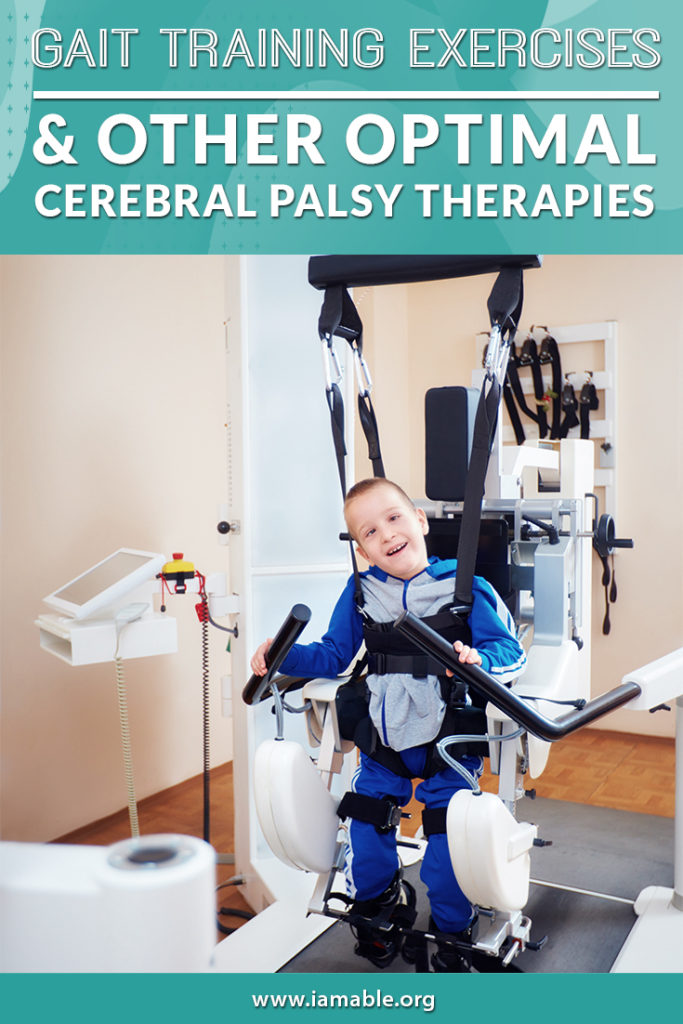Because every cerebral palsy case is a little different (and sometimes a lot different), managing the symptoms will also vary from person to person. Today, we will discuss some of the top therapies that are helping cerebral palsy patients, including gait training exercises. First, however, we should address some of the cerebral palsy symptoms that will determine the best therapies to meet a patient’s needs.
Common Cerebral Palsy Symptoms and Associated Conditions
The nature of this condition can involve symptoms from head to toe. It all depends on the location and degree of the damage or underdevelopment. Here are some of the more common ailments that a cerebral palsy patient may experience.
- Movement symptoms – Scissored gait, slow movement, lack of coordination
- Muscular symptoms – variations in tone, stiffness, spasticity, rigidity
- Neurological symptoms – intellectual disabilities, seizures, vision and hearing problems, abnormal pain receptions
- Throat symptoms – Difficulty swallowing, eating, and speaking
These are just some of the many symptoms that can be a part of cerebral palsy. Partial paralysis is also very common and may affect one or both sides of the body.
Treatment for Cerebral Palsy
Therapies for cerebral palsy break down into several categories, and their effectiveness will depend on the existing symptoms.
- Support Groups – A chronic health problem can be overwhelming to deal with, especially if you feel like no one in your life understands precisely what you are going through. A support group can help you to see that you are not alone. It can also provide you with the emotional support that you require.
- Orthotics – In order to help a patient to maintain proper alignment, orthotics may be custom fit. Orthotics cannot prevent the muscle contractions that occur due to abnormal growth, deformities, or uneven muscle tension. However, they can help to stretch the muscles and improve posture.
- Speech Therapy – Sometimes, it can be challenging to control the muscles that surround the mouth. This can make it difficult to articulate correctly. It may also help those who have difficulty swallowing or chewing.
- Occupational Therapy – This particular type of therapy helps a person get used to performing everyday activities on their own, even if some of the activities require modification. Tasks may include matters like dressing, feeding, washing, and other necessary skills.
- Physical Therapy – This covers a wide range of physical activity and exercises that strengthen a patient, improve endurance, increase range of motion, and impact overall mobility. Some activities involve the use of bodyweight, weights, mobility aids, and more. Gait training exercises and other types of physical therapy improve neuroplasticity. That is the unique ability of the brain to repair itself after injury or damage occurs.
As you can see, each of these types of therapy may be vital depending on the symptoms a patient is experiencing. Now, let’s focus a little closer on the importance of gait training exercises in particular.
The Importance of Gait Training Exercises for Cerebral Palsy Patients
Gait training exercises involve movements and therapies that improve the way a person walks. Since cerebral palsy often affects a person’s gait, this is a particularly important form of physical therapy. What are some of the potential benefits?
- Strength – As a person receives therapy to improve their gait, the muscles that activate the legs increase in power.
- Mobility – Muscles that do not have full range of motion due to rigidity can become more flexible. This can help a person to have a broader range of motion in the muscles that the body needs when walking naturally.
- Balance – To avoid falls, enhancing stability is a must. Practicing proper gait helps reduce fall risk that could lead to further injury and hardship.
These are just some of the many benefits that come from gait training. But what if walking is extremely difficult or the cerebral palsy results in some paralysis? There are still therapies that can help. Here are a couple of examples.
- Functional Electrical Stimulation (FES) – FES involves the use of electrical impulses to activate muscles that a person is unable to activate on their own. This can offer exercise to unworked muscles. FES may work in harmony with a stationary cycle to help a person living with paralysis to exercise the legs even more.
- Lokomat Therapy – This is a gait training specific device that involves suspension over an exoskeleton and treadmill. The therapist straps the patient’s legs to the exoskeleton and determines the patient’s role and the exoskeleton’s role in the process. The exoskeleton simulates a natural gait while walking on the treadmill.
In these and other ways, your ability to walk may improve. At the very least, you can get a full-body workout and strengthen the muscles.
Additional Assistance for Those Living with Cerebral Palsy
At iAM ABLE, we specialize in helping cerebral palsy patients to maximize their outcomes through traditional and modern forms of physical therapy. We also want to help people who are not in the Miami, Florida area. So whether you live locally or across the globe, we encourage you to read our eBook: 7 Unbelievably Important Steps to Take to Thrive after Paralysis.
The purpose of this publication is to help you learn to take control of your circumstance and to thrive despite the challenges that paralysis can cause. Get started on your journey today by downloading the book, and don’t forget to contact iAM ABLE to learn what our physical therapy team can do for you.
Grab our free e-book 7 Unbelievably Important Steps to Take to THRIVE after Paralysis by clicking the image below.

